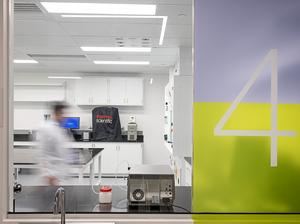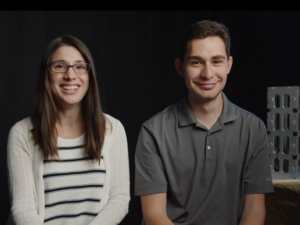Imagine, for a minute, a world with no wires. That, one could say, is the end goal for WiTricity, a company headquartered in Watertown that has revolutionized the concept of wireless charging by using magnetic coupled resonance. In recent years, the MIT spinout has been making aggressive efforts to boost awareness–and integration–of its technology, showcasing at CES, bringing on a slew of new top-level execs and adding several key players to its portfolio of licensees. Now, the firm is betting on the popularity of drones to make its tech even more attractive.
"Our vision is that by deploying a network of these wireless chargers, drones become intelligent—when they need to juice up, they can land on a wireless charging pad, juice up and continue on their flight."
How it works
WiTricity’s technology leverages magnetic forces to transmit power through the air. To achieve this, one coil is placed inside a charging station and another coil inside a device. For example, an area on a table can be turned into a wireless charging hotspot by placing a charging pad underneath it.
Of course, the concept of wireless electricity isn’t new by any means—in fact, it can be traced back to the 19th century, when Nikola Tesla used conduction-based systems to transfer wireless power. But WiTricity, founded in 2007, took an approach that’s distinctly advantageous for several reasons. Unlike the principle adopted by Nikola Tesla, their method uses resonant magnetic fields, which means no more worrying about the positioning of a device for charging. On top of that, the technology can be used to wirelessly charge multiple devices at once—and different types as well, from an iPad to a smart watch or even a car). And in this coupling resonance system, whatever energy isn’t used up by the receiver remains in the vicinity of the transmitter as opposed to being radiated into the surrounding environment. This not only ensures safety, but also minimizes wastage of power. Not to mention, WiTricity enabled people to charge multiple devices on the same surface, and can charge devices at different power levels (like—say—a BlueTooth headset, an Apple Watch and a tablet).
Clearly, there is a wide range of applications for Rezence-ready wireless charging. WiTricity showed off a few at CES, including charging in the home through the surfaces of tables, charging electric vehicles and hybrid electric vehicles, retail packaging that lights wirelessly when on a shelf, wire-free security cameras. Now, they’re exploring how wireless charging could optimize the use of drones.
Making drones smarter
Interest in UAVs has been surging in recent years for obvious reasons: they offer an unparalleled opportunity for taking photos and videos from angles that were previously not possible, and also present a wide variety of useful business applications like package delivery, equipment monitoring and even news reporting. WiTricity’s magnetic resonance technology is ideal for wireless charging of drones in part because of the spatial freedom it offers in all dimensions.
“With most wireless technology, you have to have everything perfectly aligned,” says VP of Product Management Sanjay Gupta, who joined the company in June (previously, he held the same role at Motorola).
With WiTricity, that’s not the case. Thanks to magnetic resonance, there's positional freedom: in other words, you can charge a device by setting it down anywhere on a surface. That means drones can charge anywhere on the pad without any need for precise placement, which is important when conditions are windy.
In an interview with BostInno, Gupta went on to explain that one of the most important considerations with a flying vehicle is keeping the weight as low as possible. But most drone batteries, he noted, are rather hefty.
“Our vision is that by deploying a network of these wireless chargers, drones become intelligent—when they need to juice up, they can land on a wireless charging pad, juice up and continue on their flight,” added Gupta. “This would allow them to go farther, and carry heavier payloads...which could be revolutionary in military space, among others.”
Furthermore, drones could be used to wirelessly power smartphones and other devices, as well as sensors.
Company growth and diversifying use cases
Gupta’s hire was one of several strategic additions WiTricity has made to its leadership team over the past several months. The company also brought on both Gupta and Ara Nazarian as senior vice president of engineering in June. Back in May, WiTricity added Peter Wambsganss as director of business development for Europe—an announcement that came hot off the heels licensing agreements with European battery charger manufacturer CTEK and automotive tier-1 power electronics supplier BRUSA. Now, the firm—which has more than 80 employees—is hiring for several engineering positions.
So they’re obviously gaining traction. But there’s just one little problem: Commercializing what WiTricity is trying to do is not easy.
“We need to create an ecosystem to make sure that everyone wants to adopt the technology — so it’s not just one vendor’s products including it, but every one,” explained Gupta. “We need to create a standard that increases the market size.”
To its credit, WiTricity has acquired hundreds of patents, and has been steadily building up a network of Fortune 500 partners. Intel, for example, adopted the company’s Rezence standard for a batch of laptops that are slated to hit before the end of the year, and Toyota is leveraging its tech for wireless electric vehicle charging, likely for the Prius. The medical industry wants in, too: Imagine a heart pump that doesn’t require wires exiting the chest cavity—that translates to a far lower risk of infection.
“Wireless charging opens up very interesting possibilities for delivering therapies for diseases,” said Gupta. “Traditional therapy is basically all chemical-based … but current research asks: ‘what if we provide therapy via electrical stimulation?’ The challenge there is—you’re putting batteries in people’s bodies. And that's where WiTricity’s technology comes in handy."
At the end of 2014, WiTricity announced its A4WP Partner Program, which makes it easier for organizations to integrate the company’s wireless power technology into products designed for the A4WP Rezence specification. The company also revealed the WiT-5000C3 development kit, the first in a series of reference design kits for companies looking to kick-start the creation of A4WP Rezence-ready devices.
Gupta noted that WiTricity has spent a lot of time driving standards so consumers don’t have to worry about compatibility. More recently, they’ve been honing in on the aspect of manufacturing efficiency. They’re currently working closely with manufacturers with Asia, bringing them up to speed on the technology so that they can more quickly bring products and solutions that embed it to market.
“The sooner we can drive the price points down for the technology, the better,” added Gupta. “Keeping that in mind, we expect the first applications to be more in the consumer electronics space—because that’s where the volume and scale is. That, we think, will serve as the engine to power wireless technology.”
All images via WiTricity.








